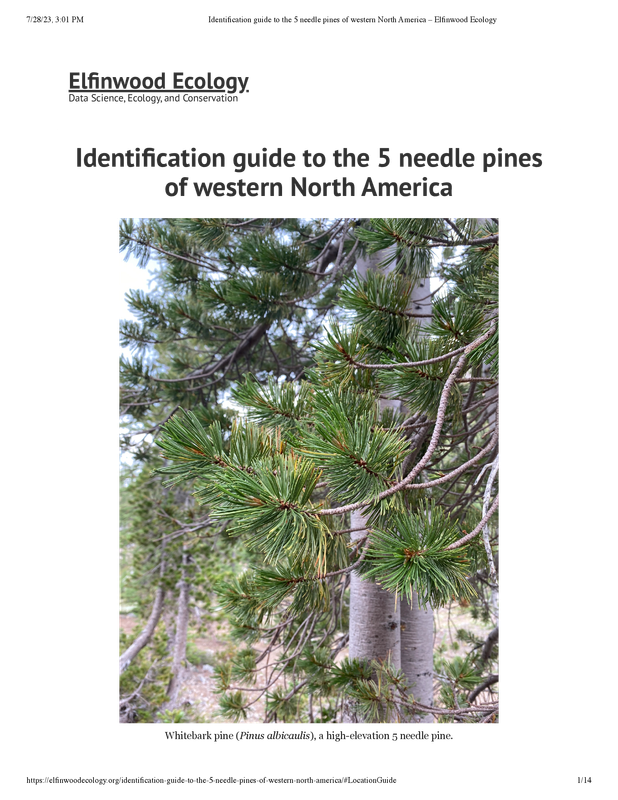
The 5-Needles Pines Community Science Project is a collaboration among the Whitebark Pine Ecosystem Foundation, Pacific Crest Trail Association and California Native Plant Society to map and inventory five-needle pine species along the Pacific Crest National Scenic Trail, which runs more than 2,600 miles from Mexico to Canada. We're reaching out to you because we hope you join the project and participate by adding observations and making identifications. Read on to learn more about this project.
About
The five-needle pines of the Western North America are in trouble. Join the 5-Needle Pines Community Science Project to help increase awareness of the changes affecting our world while improving connections to nature. Working together to document what’s happening is a positive step toward recovery. Five-needle pines along the trail include the sugar pine, limber pine, foxtail pine, whitebark pine and western white pine. Crucial to their mountain ecosystems, these trees face an uncertain future, and scientists are trying to learn more. Beginning from the southern end of the PCT and moving north, the five-needle pines seen in order of appearance along the trail are sugar pine, limber pine, foxtail pine, whitebark pine, and western white pine. Comparing these species, sugar pines prefer mid-elevations and have the longest needles and cones. Limber pines are only found in the high, arid regions of the Transverse Ranges, Peninsular Range, and southern Sierra Nevada. Foxtail pines make their homes in the high elevations of the southern Sierra Nevada and Klamath Mountains. Whitebark pines stick to the high elevations in the central Sierra and north to Canada. Western white pines live in middle to upper elevations from the central Sierra northward. Western white pines’ cones and needles are medium in length, compared with those of the sugar pines and limber pines.

Participating in the 5-Needle Pine Project
1) Join our iNaturalist project to stay up to date with events and news
2) Pictures. Pictures. Pictures.
Take pictures of five-needle pines along the PCT. Include the whole tree, bark, and needle close-ups clearly showing the number of needles per bundle and cones (if present). If you don’t see cones, look closely around the base of the tree for cone fragments and photograph those (if present). If the tree is showing signs of decline like top or branch dieback, include a picture of that, too.




Whitebark Pine (Pinus albicaulis
© Aaron Wells (CC-BY-NC)
https://www.inaturalist.org/observations/137368972
3) Complete the Observation Fields

4) Identify!
Join in helping identify the observations already uploaded on the project!
https://www.inaturalist.org/observations/identify?project_id=148443
Check out our resources section below for ID guides!
Resources:
Identification Guide to the 5-Needle Pines of the Pacific Crest Trail (PDF):
https://www.pcta.org/wp-content/uploads/2023/01/5-Needle-Pine-PCT-ID-Guide_2023.pdf?x60759

Identification guide to the 5 needle pines of western North America:
https://elfinwoodecology.org/identification-guide-to-the-5-needle-pines-of-western-north-america/
You are tagged in this post because you are among some of the top identifiers and observers of Whitebark Pine (Pinus albicaulis), Foxtail Pine (Pinus balfouriana), Limber Pine (Pinus flexilis), Sugar Pine (Pinus lambertiana), Western White Pine (Pinus monticola). We hope you take part in this project. Feel free to share this with other Naturalists who you think would like to participate.
@drew_meyer @chris_earle @plachuff @grnleaf @calebcatto @matt_g @tmessick @michaelkauffmann @kwright @sabeaumont @jdmore @twainwright @gordonhogenson @ajwright @cwbarrows @sedgequeen @charlie @once-ler @chauncey @sekihiker @cwbarrows @justinaceae @brewbooks @connectacopia @aaronfwells @erik-jules @lagoondon @tyannasb @garyg @geographerdave @twr61 @damontighe @johnreiss @jrmorris @mattlavin @sheriff_woody_pct @thikeshikes @danjuel @walterfertig @whitneybrook @ipomopsis @richardlb @adriandeg @stewartwechsler @pnwids @burchfielddavidr @adrian_albicaulis @judithofsquamish @tchester @owdegroff @graysquirrel @tonnessen














